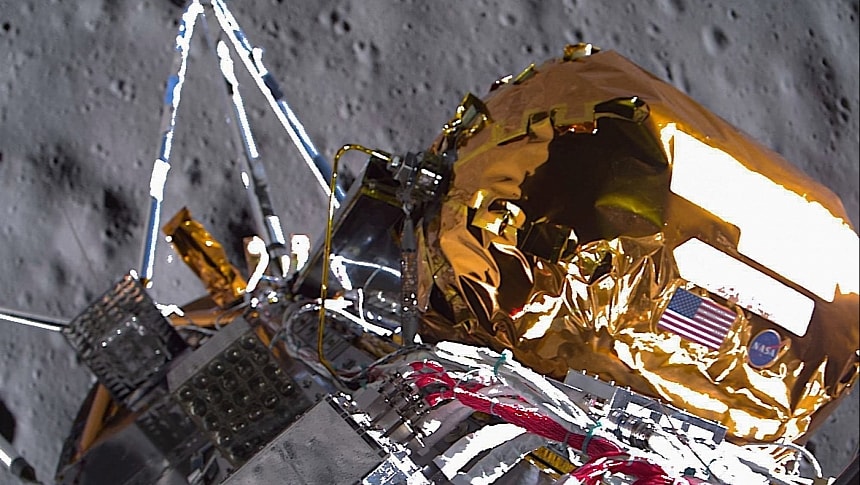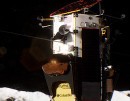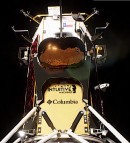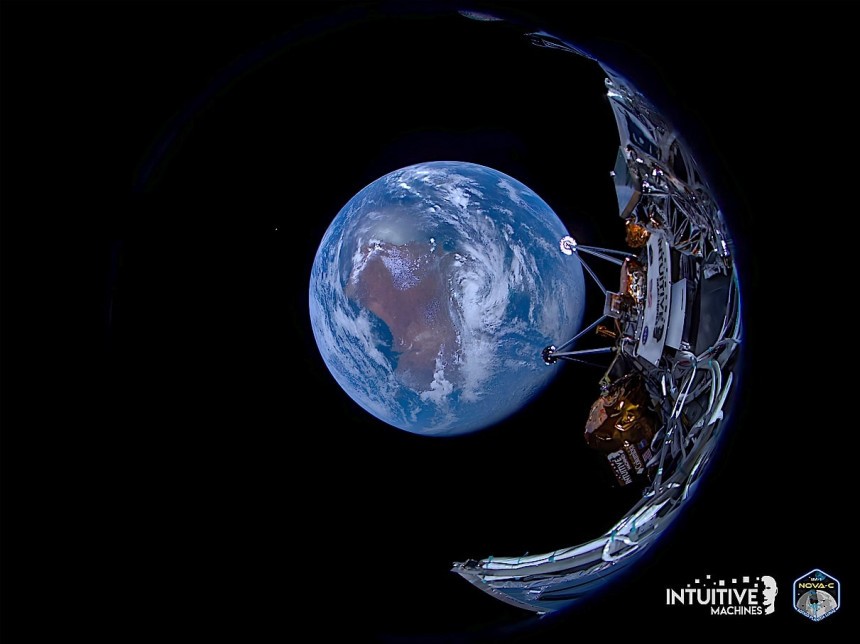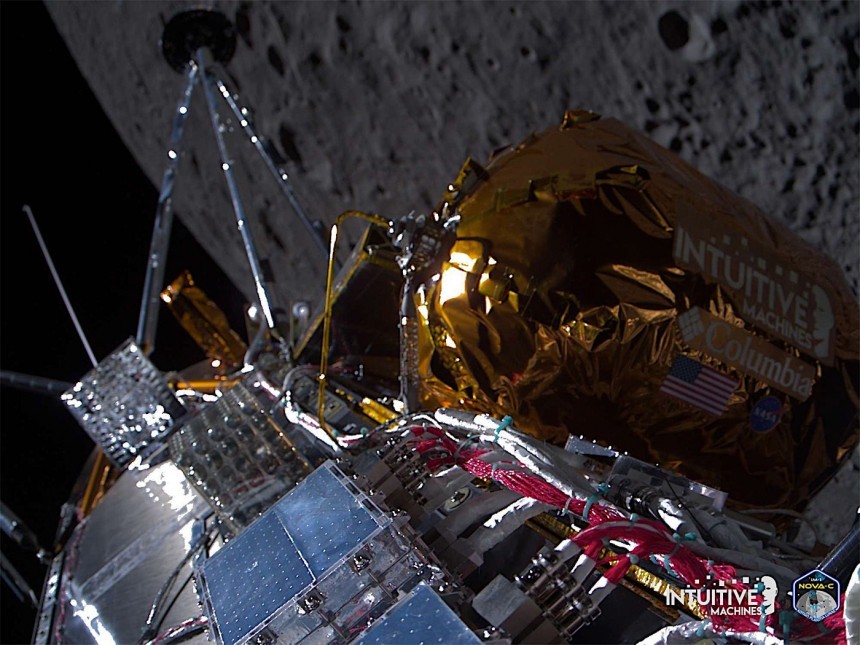Just two short weeks ago a piece of hardware developed in America landed on the Moon. It was a momentous occasion because despite the U.S being the only one in the world to have landed humans up there, the country hasn't sent anything to the Moon in more than half a century.
The spacecraft that managed to break the streak was called Odysseus. A lander of a family called Nova-C, the hardware was developed by private space company Intuitive Machines as part of NASA's Commercial Lunar Payload Services (CLPS) program.
The lander was actually the second piece of hardware from the program to be launched this year, but given how its predecessor, the Astrobotic Peregrine, failed on its way to the Moon, the Odysseus made history by becoming the first American piece of tech to land on Luna in 50+ years.
Set down in the Malapert A region of the satellite's South Pole, the Odysseus managed to impress the world and its operators with the amount of data it sent back. It was never meant to last long, just a week, and it is now no longer operational, but the data it delivered will likely keep some humans busy for months to come.
We probably already know by now the lander carried with it a total of 12 payloads, six paid for by private companies, and the other six by NASA itself. We've discussed the private cargo in a previous story, but now that the mission is over and the space agency is confident enough to share its enthusiasm, it's time to have a closer look at the NASA instruments as well.
And we'll open with something we've already discussed at length in a previous story, the Lunar Node-1. Technically a wannabe precursor to a navigation network on the Moon, it was meant to test the tech nav system that relies on the location of various markers on the surface to confirm position.
During the seven days or so it was operational on the Moon, the Lunar Node was "powered on, performed surface operations, and received data." It's unclear at this point exactly what that means, but we'll probably learn as soon as NASA people are done going through the numbers.
Something called the Radio Frequency Mass Gauge was also deployed for the first time on a mission, with its main goal being to estimate just how much fuel was left in the ship's tank. Although not meant to take an exact measurement, but it could prove a big improvement compared to current systems.
You see, unlike here on Earth where the fuel in a tank can be easily measured thanks to various gadgets and, well, gravity, the same thing can't be easily done in space, where fuel does not sink to the bottom of the tank, but clings to its walls.
NASA says the hardware meant to overcome the difficulties posed by this reality worked and received data during the Odysseus mission as well, but in this case too the data that was received was not yet analyzed.
The third instrument NASA tested on the Intuitive Machines lander is something called the Navigation Doppler Lidar. As it's partially revealed by its name, the tool was meant to "provide precise altitude, speed, and direction to the guidance, navigation, and control (GNC) subsystem" of the Odysseus.
And it did just that, acting as a backup system for the spacecraft's primary nav systems, at the same time returning that that is, you guessed it, still being analyzed. The tool relied on a laser to measure altitude relying on the Doppler effect to determine direction and speed incredibly accurately, down to a few centimeters per second.
The Radio-wave Observations at the Lunar Surface of the Photoelectron Sheath (ROLSES) instrument was used to have a look at the photoelectron sheath density and scale height in close proximity to the lunar surface.
Based on the instrument's findings, which are yet to be made public, NASA hopes to get a better understanding of how the environment up on the Moon will impact the operation of future radio observatories to be placed there.
Fifth on the list of NASA tools that operated while Odysseus was up and running was the Stereo Cameras for Lunar Plume-Surface Studies (SCALPSS). That's a fancy name for a number of cameras that were used both during the voyage out and after landing to take snapshots of how the lander's plume affects the lunar surface upon landing.
This is the only of six instruments to have partially failed, as even if it was powered on and snapped a few images during transit and after landing, it did not do the same at the most critical moment of the mission, the actual touchdown.
Last but not least the Laser Retroreflector Array (LRA) was to be used to determine the exact location of the lander by relying on laser reflected from an orbiting spacecraft. In doing so, it would have become the first permanent location marker on the surface of the satellite.
As per NASA, the instrument is now in passive mode, but that's a good thing: there's a good chance the Lunar Reconnaissance Orbiter can use it for ranging.
All in all, NASA says all instruments have met their "pre-launch projected mission operations," marking a historic moment in the life of the Artemis Moon exploration program.
The lander was actually the second piece of hardware from the program to be launched this year, but given how its predecessor, the Astrobotic Peregrine, failed on its way to the Moon, the Odysseus made history by becoming the first American piece of tech to land on Luna in 50+ years.
Set down in the Malapert A region of the satellite's South Pole, the Odysseus managed to impress the world and its operators with the amount of data it sent back. It was never meant to last long, just a week, and it is now no longer operational, but the data it delivered will likely keep some humans busy for months to come.
We probably already know by now the lander carried with it a total of 12 payloads, six paid for by private companies, and the other six by NASA itself. We've discussed the private cargo in a previous story, but now that the mission is over and the space agency is confident enough to share its enthusiasm, it's time to have a closer look at the NASA instruments as well.
And we'll open with something we've already discussed at length in a previous story, the Lunar Node-1. Technically a wannabe precursor to a navigation network on the Moon, it was meant to test the tech nav system that relies on the location of various markers on the surface to confirm position.
During the seven days or so it was operational on the Moon, the Lunar Node was "powered on, performed surface operations, and received data." It's unclear at this point exactly what that means, but we'll probably learn as soon as NASA people are done going through the numbers.
You see, unlike here on Earth where the fuel in a tank can be easily measured thanks to various gadgets and, well, gravity, the same thing can't be easily done in space, where fuel does not sink to the bottom of the tank, but clings to its walls.
NASA says the hardware meant to overcome the difficulties posed by this reality worked and received data during the Odysseus mission as well, but in this case too the data that was received was not yet analyzed.
The third instrument NASA tested on the Intuitive Machines lander is something called the Navigation Doppler Lidar. As it's partially revealed by its name, the tool was meant to "provide precise altitude, speed, and direction to the guidance, navigation, and control (GNC) subsystem" of the Odysseus.
And it did just that, acting as a backup system for the spacecraft's primary nav systems, at the same time returning that that is, you guessed it, still being analyzed. The tool relied on a laser to measure altitude relying on the Doppler effect to determine direction and speed incredibly accurately, down to a few centimeters per second.
The Radio-wave Observations at the Lunar Surface of the Photoelectron Sheath (ROLSES) instrument was used to have a look at the photoelectron sheath density and scale height in close proximity to the lunar surface.
Fifth on the list of NASA tools that operated while Odysseus was up and running was the Stereo Cameras for Lunar Plume-Surface Studies (SCALPSS). That's a fancy name for a number of cameras that were used both during the voyage out and after landing to take snapshots of how the lander's plume affects the lunar surface upon landing.
This is the only of six instruments to have partially failed, as even if it was powered on and snapped a few images during transit and after landing, it did not do the same at the most critical moment of the mission, the actual touchdown.
Last but not least the Laser Retroreflector Array (LRA) was to be used to determine the exact location of the lander by relying on laser reflected from an orbiting spacecraft. In doing so, it would have become the first permanent location marker on the surface of the satellite.
As per NASA, the instrument is now in passive mode, but that's a good thing: there's a good chance the Lunar Reconnaissance Orbiter can use it for ranging.
All in all, NASA says all instruments have met their "pre-launch projected mission operations," marking a historic moment in the life of the Artemis Moon exploration program.
